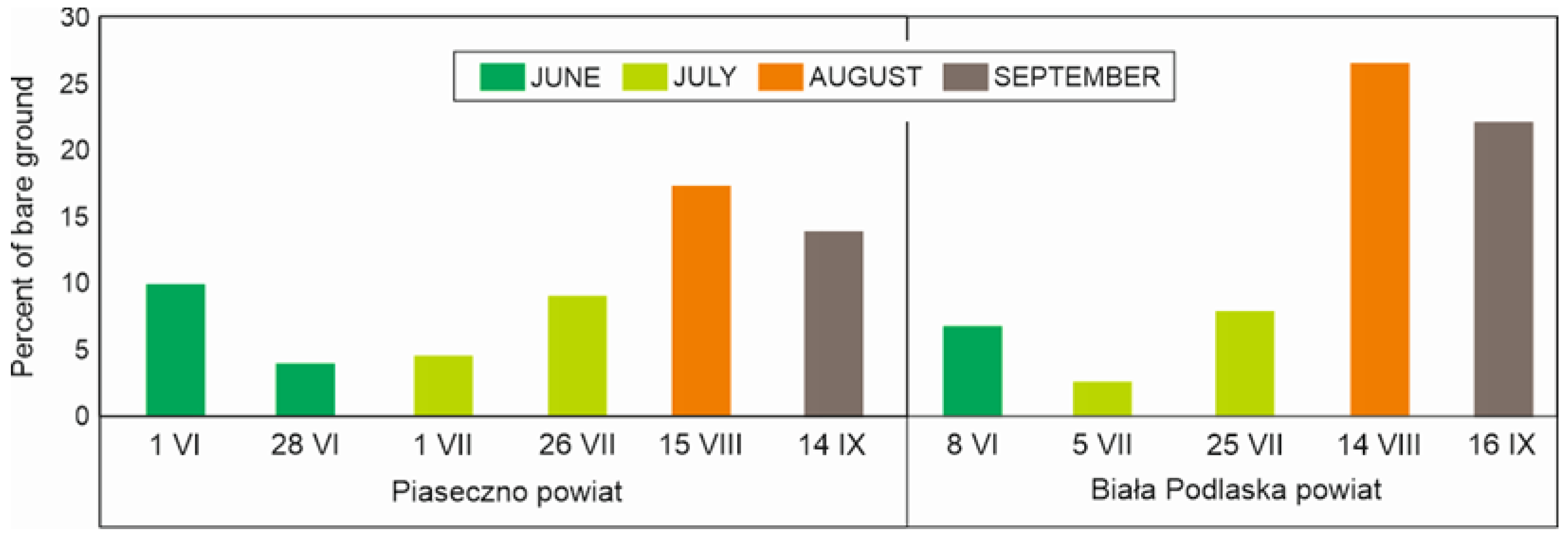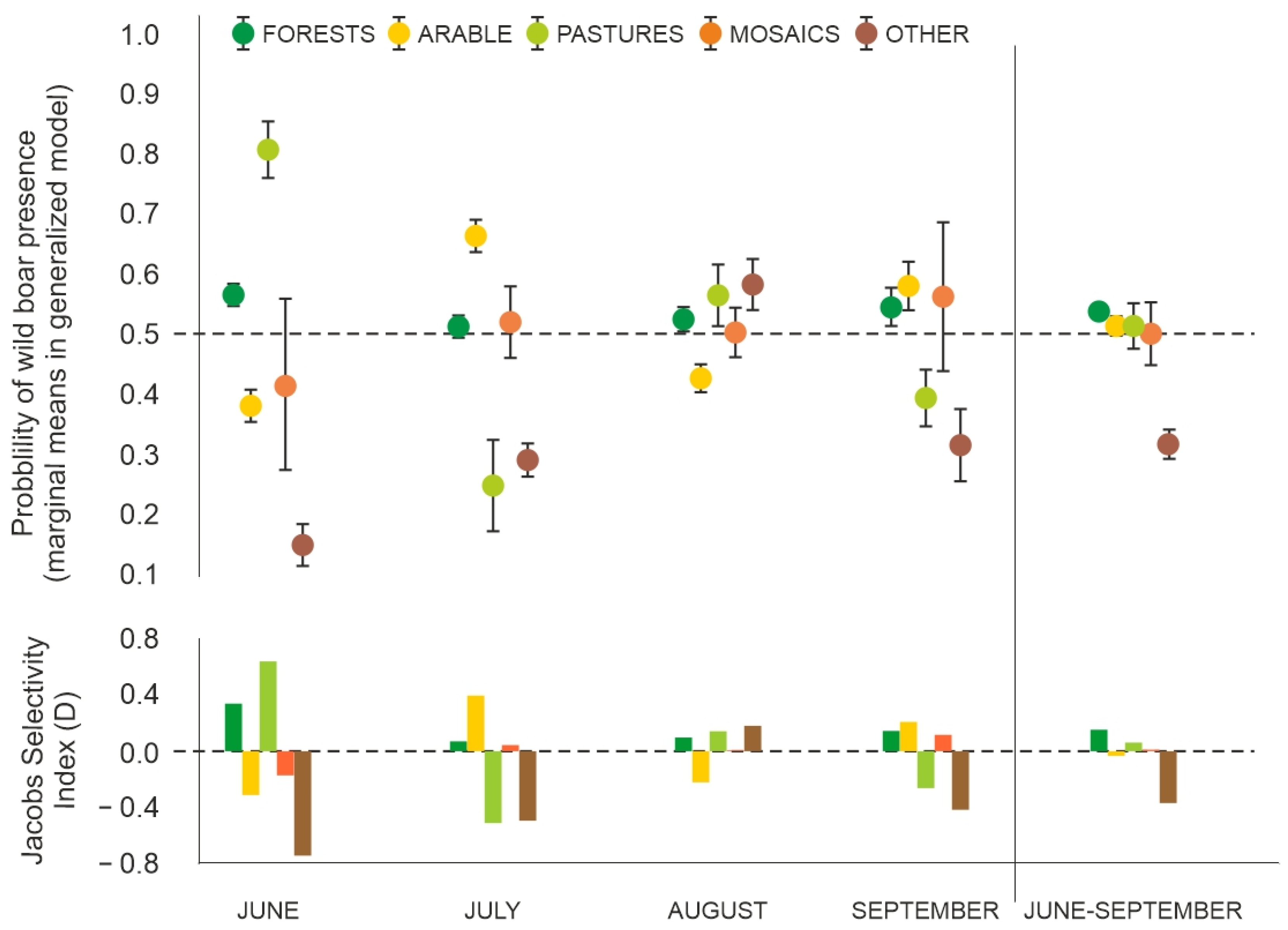Crop Harvesting Can Affect Habitat Selection of Wild Boar (Sus scrofa)
Abstract
1. Introduction
2. Materials and Methods
3. Results
4. Discussion
5. Conclusions
Supplementary Materials
Author Contributions
Funding
Institutional Review Board Statement
Informed Consent Statement
Data Availability Statement
Acknowledgments
Conflicts of Interest
References
- Massei, G.; Kindberg, J.; Licoppe, A.; Gačić, D.; Šprem, N.; Kamler, J.; Baubet, E.; Hohmann, U.; Monaco, A.; Ozoliņš, J.; et al. Wild boar populations up, numbers of hunters down? A review of trends and implications for Europe. Pest Manag. Sci. 2015, 71, 492–500. [Google Scholar] [CrossRef]
- Ballari, S.A.; Barrios-Garcia, M.N. A review of wild boar Sus scrofa diet and fsactors affecting food selection in native and introduced ranges. Mamm. Rev. 2014, 44, 124–134. [Google Scholar] [CrossRef]
- Gethöffer, F.; Sodeikat, G.; Pohlmeyer, K. Reproductive parameters of wild boar (Sus scrofa) in three different parts of Germany. Eur. J. Wildl. Res. 2007, 53, 287–297. [Google Scholar] [CrossRef]
- Apollonio, M.; Anderson, R.; Putman, R. European Ungulates and Their Management in the 21st Century; Cambridge University Press: Cambridge, UK, 2010. [Google Scholar]
- Massei, G.; Roy, S.; Bunting, R. Too many hogs? A review of methods to mitigate impact by wild boar and feral hogs. Hum.-Wildl. Interact. 2011, 5, 79–99. [Google Scholar] [CrossRef]
- Fruziński, B.; Łabudzki, L. Management of wild boar in Poland. Z. Jagdwissenshaft 2002, 48, 201–207. [Google Scholar] [CrossRef]
- Acevedo, P.; Quirós-Fernández, F.; Casal, J.; Vicente, J. Spatial distribution of wild boar population abundance: Basic information for spatial epidemiology and wildlife management. Ecol. Indic. 2014, 36, 594–600. [Google Scholar] [CrossRef]
- Laguna, E.; Barasona, J.A.; Vicente, J.; Keuling, O.; Acevedo, P. Differences in wild boar spatial behaviour among land uses and management scenarios in Mediterranean ecosystems. Sci. Total Environ. 2021, 796, 148966. [Google Scholar] [CrossRef]
- Massei, G.; Genov, P.V.; Staines, B.W.; Gorman, M.L. Factors influencing home range and activity of wild boar (Sus scrofa) in a Mediterranean coastal area. J. Zool. 1997, 242, 411–423. [Google Scholar] [CrossRef]
- Calenge, C.; Maillard, D.; Vassant, J.; Brandt, S. Summer and hunting season home range of wild boar (Sus scrofa) in two habitats in France. Game Wildl. Sci. 2002, 19, 281–302. [Google Scholar]
- Sodeikat, G.; Pohlymeyer, K. Temporary home range modifications of wild boar family groups (Sus scrofa L.) caused by drive hunts in Lower Saxony (Germany). Z. Jagdwiss. 2002, 48, 161–166. [Google Scholar] [CrossRef]
- Maillard, D.; Fournier, P. Effect of shooting with hounds on home range size of wild boar (Sus scrofa L.) groups in Mediterranean habitat. J. Mt. Ecol. 1995, 3, 102–107. [Google Scholar]
- Saïd, S.; Tolon, V.; Brandt, S.; Baubet, E. Sex effect on habitat selection in response to hunting disturbance: The study of wild boar. Eur. J. Wildl. Res. 2012, 58, 107–115. [Google Scholar] [CrossRef]
- Janoska, F.; Farkas, A.; Marosan, M.; Fodor, J.T. Wild boar (Sus scrofa) home range and habitat use in two Romanian habitats. Acta Silv. Lignaria Hung. 2018, 14, 51–63. [Google Scholar] [CrossRef]
- Johann, F.; Handschuh, M.; Linderothm, P.; Heurich, M.; Dormann, C.F.; Arnold, J. Variability of daily space use in wild boar Sus scrofa. Wildl. Biol. 2020, 1, 1–12. [Google Scholar] [CrossRef]
- Dinter, U. Das Raum-Zeitverhalten von Schwarzwild im Grunewald in den Sommermonaten unter Besonderer Berücksichtigung Menschlicher Störungen. Ph.D. Thesis, Ludwig-Maximilian-Universität, München, Germany, 1991. [Google Scholar]
- Keuling, O.; Stier, N.; Roth, M. How does hunting influence activity and spatial usage in wild boar Sus scrofa L.? Eur. J. Wildl. Res. 2008, 54, 729–737. [Google Scholar] [CrossRef]
- Nasiadka, P.; Janiszewski, P. Food preferences of wild boars (Sus scrofa L.) in the summer and early autumn expressed by the damage caused in agricultural crops. Sylwan 2015, 159, 307–317. [Google Scholar] [CrossRef]
- Gimenez-Anaya, A.; Herrero, J.; Rosell, C.; Couto, S.; Garcia-Serrano, A. Food habits of wild boars (Sus scrofa) in a Mediterranean coastal wetland. Wetlands 2008, 28, 197–203. [Google Scholar] [CrossRef]
- Schley, L.; Dufrene, M.; Krier, A. Patterns of crop damage by wild boar (Sus scrofa) in Luxembourg over a 10-year period. Eur. J. Wildl. Res. 2008, 54, 589–599. [Google Scholar] [CrossRef]
- Bleier, N.; Kovacs, I.; Schally, G.; Szemethy, L.; Csanyi, S. Spatial and temporal characteristics of the damage caused by wild ungulates in maize (Zea mays L.) crops. Int. J. Pest Manag. 2017, 63, 92–100. [Google Scholar] [CrossRef]
- Fuller, R.J.; Norton, L.R.; Feber, R.E.; Johnson, P.J.; Chamberlain, D.E.; Joys, A.C.; Mathews, F.; Stuart, R.C.; Townsend, M.C.; Manley, W.J.; et al. Benefits of Organic Farming to Biodiversity Vary among Taxa. Biol. Lett. 2005, 1, 431–434. [Google Scholar] [CrossRef] [PubMed]
- VanBeek, K.R.; Brawn, J.D.; Ward, M.P. Does no-till soybean farming provide any benefits for birds? Agric. Ecosyst. Environ. 2014, 185, 59–64. [Google Scholar] [CrossRef]
- Jacobs, J. Quantitative measurement of food selection. Oecologia 1974, 14, 413–417. [Google Scholar] [CrossRef] [PubMed]
- Sheffield, K.; Morse-McNabb, E. Using satellite imagery to asses trends in soil and crop productivity across landscapes. IOP Conf. Ser. Earth Environ. Sci. 2015, 25, 012013. [Google Scholar] [CrossRef]
- Novák, J.; Lukas, V.; Rodriguez Moreno, F.; Křen, J. Assessment of Soil Variability of South Moravian Region Based on the Satellite Imagery. Acta Univ. Agric. Silv. Mendel. Brun. 2018, 66, 119–129. [Google Scholar] [CrossRef]
- Campos, L.R.; Demattê, J.A.; Bellinaso, H.; Poppiel, R.R.; Greschuk, L.T.; Rizzo, R.; Rosin, N.A.; Rosas, J.T.F. Detection of bare soils in sugarcane areas by temporal satellite images: A monitoring technique for soil security. Soil Secur. 2022, 7, 100057. [Google Scholar] [CrossRef]
- Tempa, K.; Aryal, K.R. Semi-automatic classification for rapid delineation of the geohazard-prone areas using Sentinel-2 satellite imagery. SN Appl. Sci. 2022, 4, 141. [Google Scholar] [CrossRef]
- Herrero, J.; García-Serrano, A.; Couto, S.; Ortuño, V.M.; García-González, R. Diet of wild boar Sus scrofa L. and crop damage in an intensive agroecosystem. Eur. J. Wildl. Res. 2006, 52, 245–250. [Google Scholar] [CrossRef]
- Rivero, M.J.; Rodríguez-Estévez, V.; Pietrosemoli, S.; Carballo, C.; Cooke, A.S.; Kongsted, A.G. Forage consumption and its effects on the performance of growing swine—discussed in relation to European wild boar (Sus scrofa L.) in semi-extensive systems: A review. Animals 2019, 9, 457. [Google Scholar] [CrossRef]
- Terlikowski, J. The impact of the intensity of using permanent and alternating meadows on the quality of fodder and potential milk production. In Proceedings of the Gdańsk–Lipce, Poland, 23 September 1999; Wydawnictwo Przedsiębiorstwo Marketingowe „LOGO”: Gdańsk, Poland, 2000. (In Polish) [Google Scholar]
- Piekarczyk, P.; Tajchman, K.; Belova, O.; Wójcik, M. Crop damage by wild boar (Sus scrofa L.) depending on the crop composition in Central-Eastern Poland. Balt. For. 2021, 27, 86–96. [Google Scholar] [CrossRef]
- Barrios-Garcia, M.N.; Ballardi, S.A. Imapact of wild boar (Sus scrofa) in its introduced and native range: A review. Biol. Invasions 2012, 14, 2283–2300. [Google Scholar] [CrossRef]
- Amici, A.; Serrani, F.; Rossi, C.M. Increase in crop damage caused by wild boar (Sus scrofa L.): The “refuge effect”. Agron. Sustain. Dev. 2012, 32, 683–692. [Google Scholar] [CrossRef]
- Cappa, F.; Bani, L.; Meriggi, A. Factors affecting the crop damage by wild boar (Sus scrofa) and effects of population control in the Ticino and Lake Maggiore Park (North-western Italy). Mamm. Biol. 2021, 101, 451–463. [Google Scholar] [CrossRef]
- Muthoka, C.M.; Andren, H.; Nyaga, J.; Augustsson, E.; Kjellander, P. Effect of supplemental feeding on habitat and crop selection by wild boar in Sweden. Ethol. Ecol. Evol. 2022, 1–19. [Google Scholar] [CrossRef]
- Nieróbca, A.; Kozyra, J.; Mizak, K.; Wróblewska, E. Changing length of the growing season in Poland. Woda-Sr.-Obsz. Wiej. 2013, 13, 81–94. (In Polish) [Google Scholar]
- Wróbel, B.; Terlikowski, J.; Wesołowski, P.; Barszczewski, J. Rational Use of Lowland Meadows; Wydawnictwo ITP: Falenty, Poland, 2015. (In Polish) [Google Scholar]
- Zawadzki, A.; Szuba-Trznadel, A.; Fuchs, B. The Base of Nourishment, Characteristic of Population and Breeding Season of Wild Boars (Sus scrofa) in the Kaczawskie Mountains; Zeszyty Naukowe Uniwersytetu Przyrodniczego we Wrocławiu—Biologia i Hodowla Zwierząt: Wrocław, Poland, 2011; Volume 583, pp. 363–376. (In Polish) [Google Scholar]
- Mazzoni Della Stella, R.; Calovi, F.; Burrini, L. The wild boar management in a province of central Italy. IBEX J. Mt. Ecol. 1995, 3, 213–216. [Google Scholar]
- Vassant, J. Le sanglier en France: Ces quinze dernières années. Office National de la Chasse, Paris, France. Bull. Mens. 1997, 225, 32–35. (In French) [Google Scholar]
- Hahn, N.; Eisfeld, D. Diet and habitat use of wild boar (Sus scrofa) in SW-Germany. Gibier Faune Sauvag. 1998, 15, 595–606. [Google Scholar]
- Johann, F.; Handschuh, M.; Linderoth, P.; Dormann, C.F.; Arnold, J. Adaptation of wild boar (Sus scrofa) activity in a human-dominated landscape. BMC Ecol. 2020, 20, 4. [Google Scholar] [CrossRef]
- Lombardini, M.; Meriggi, A.; Fozzi, A. Factors influencing wild boar damage to agricultural crops in Sardinia (Italy). Curr. Zool. 2017, 63, 507–514. [Google Scholar] [CrossRef]
- Boyce, C.M.; VerCauteren, K.C.; Beasley, J.C. Timing and extent of crop damage by wild pigs (Sus scrofa Linnaeus) to corn and peanut fields. Crop Prot. 2020, 133, 105131. [Google Scholar] [CrossRef]
- Castillo-Contreras, R.; Carvalho, J.; Serrano, E.; Mentaberre, G.; Fernández-Aguilar, X.; Colom-Cadena, A.; Gonzalez-Crespo, C.; Lavin, S.; López-Olvera, J.R. Urban wild boars prefer fragmented areas with food resources near natural corridors. Sci. Total Environ. 2018, 615, 282–288. [Google Scholar] [CrossRef] [PubMed]
- Laguna, E.; Barasona, J.A.; Carpio, A.J.; Vicente, J.; Acevedo, P. Permeability of artificial barriers (fences) for wild boar Sus scrofa in Mediterranean mixed landscapes. Pest Manag. Sci. 2022, 78, 2277–2286. [Google Scholar] [CrossRef] [PubMed]
- Wu, H.; Hubbard, K.G.; Wilhite, D.A. An agricultural drought risk-assessment model for corn and soybeans. Int. J. Climatol. 2004, 24, 723–741. [Google Scholar] [CrossRef]
- Vercauteren, K.C.; Hygnstrom, S.E. Effects of agricultural activities and hunting on home ranges of female white-tailed deer. J. Wildl. Manag. 1998, 62, 280–285. [Google Scholar] [CrossRef]
- Marboutin, E.; Aebischer, N.J. Does harvesting arable crops influence the behaviour of the European hare Lepus europaeus? Wildl. Biol. 1996, 2, 83–91. [Google Scholar] [CrossRef]
- Erdtmann, D.; Keuling, O. Behavioural patterns of free roaming wild boar in a spatiotemporal context. PeerJ 2020, 8, e10409. [Google Scholar] [CrossRef] [PubMed]
- Drimaj, J.; Kamler, J.; Homolka, M.; Mikulka, O.; Plhal, R.; Brázdil, R. Floodplain forest as an ideal environment for the reproduction of wild boar? Eur. J. Wildl. Res. 2021, 67, 89. [Google Scholar] [CrossRef]
- Fournier-Chambrillon, C.; Maillard, D.; Fournier, P. Variabilité du régime alimentaire du sanglier (Sus scrofa L.) dans les garrigues de Montpellier (Hérault). Gibier Faune Sauvage 1996, 13, 1457–1476. (In French) [Google Scholar]
- Groot Bruinderink, G.W.T.A.; Hazebroek, E.; van der Voot, H. Diet and condition of wild boar, Sus scrofa scrofa, without supplementary feeding. J. Zool. 1994, 233, 631–648. [Google Scholar] [CrossRef]
- Gaudiano, L.; Pucciarelli, L.; Frassanito, A.G.; Mori, E.; Morimando, F.; Silvestri, F.M.; Sorino, R.; Viviano, A.; Corriero, G. Spatio-temporal behaviour of female wild boar in an agro-forestry–pastoral landscape of Southern Italy. Mamm. Res. 2022, 67, 163–172. [Google Scholar] [CrossRef]



Publisher’s Note: MDPI stays neutral with regard to jurisdictional claims in published maps and institutional affiliations. |
© 2022 by the authors. Licensee MDPI, Basel, Switzerland. This article is an open access article distributed under the terms and conditions of the Creative Commons Attribution (CC BY) license (https://creativecommons.org/licenses/by/4.0/).
Share and Cite
Popczyk, B.; Klich, D.; Nasiadka, P.; Sobczuk, M.; Olech, W.; Kociuba, P.; Gadkowski, K.; Purski, L. Crop Harvesting Can Affect Habitat Selection of Wild Boar (Sus scrofa). Sustainability 2022, 14, 14679. https://doi.org/10.3390/su142214679
Popczyk B, Klich D, Nasiadka P, Sobczuk M, Olech W, Kociuba P, Gadkowski K, Purski L. Crop Harvesting Can Affect Habitat Selection of Wild Boar (Sus scrofa). Sustainability. 2022; 14(22):14679. https://doi.org/10.3390/su142214679
Chicago/Turabian StylePopczyk, Bartłomiej, Daniel Klich, Paweł Nasiadka, Maria Sobczuk, Wanda Olech, Piotr Kociuba, Krzysztof Gadkowski, and Ludwik Purski. 2022. "Crop Harvesting Can Affect Habitat Selection of Wild Boar (Sus scrofa)" Sustainability 14, no. 22: 14679. https://doi.org/10.3390/su142214679
APA StylePopczyk, B., Klich, D., Nasiadka, P., Sobczuk, M., Olech, W., Kociuba, P., Gadkowski, K., & Purski, L. (2022). Crop Harvesting Can Affect Habitat Selection of Wild Boar (Sus scrofa). Sustainability, 14(22), 14679. https://doi.org/10.3390/su142214679







